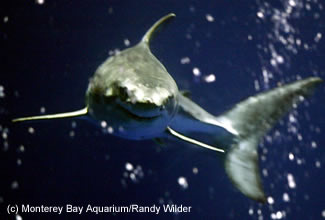 Zoos are prisons, captivity of wild animals is torture and a death sentence. And its justification is usually as lame as this ..... Monterey Aquarium's Great White Shark Stirs Controversy, Attracts Crowds; 'Certain Species Don't Do Well in Captivity' Aquarium spokesman, Ken Peterson. He maintains that having a Great White in captivity is ultimately beneficial to the species. "Tens to hundreds of millions of sharks being killed in the wild is a serious conservation problem for the oceans that needs to be addressed. One of the effective vehicles we as a public aquarium have for reaching people, getting them to care about these issues and take action, is to introduce them to live animals."Capitivity is sure to kill this shark. And the hysterically inaccurate statement that; "hundreds of MILLIONS" are killed in the wild is used to justify the killing of this one shark.
Zoos are prisons, captivity of wild animals is torture and a death sentence. And its justification is usually as lame as this ..... Monterey Aquarium's Great White Shark Stirs Controversy, Attracts Crowds; 'Certain Species Don't Do Well in Captivity' Aquarium spokesman, Ken Peterson. He maintains that having a Great White in captivity is ultimately beneficial to the species. "Tens to hundreds of millions of sharks being killed in the wild is a serious conservation problem for the oceans that needs to be addressed. One of the effective vehicles we as a public aquarium have for reaching people, getting them to care about these issues and take action, is to introduce them to live animals."Capitivity is sure to kill this shark. And the hysterically inaccurate statement that; "hundreds of MILLIONS" are killed in the wild is used to justify the killing of this one shark.
The reality is yes tens of millions are sharks are killed annually and the way to stop that is to stop the Chinese Soup industry.
Imprisoning rare Great White's and assuring them a speeding death has nothing to do with shark slaughter in the wild.
Triple Threat: World Fin Trade May Harvest September 2006
The first real-data study of sharks harvested for their valuable fins estimates as few as 26 million and as many as 73 million sharks are killed each year worldwide—three times higher than was reported originally by the United Nations, according to a paper published as the cover story in the October 2006 edition of Ecology Letters.
“The shark fin trade is notoriously secretive. But we were able tap into fin auction records and convert from fin sizes and weights to whole shark equivalents to get a good handle on the actual numbers,” says lead author Shelley Clarke, Ph.D, an American fisheries scientist based in Hong Kong and Japan.
A team of researchers calculated the number of sharks represented in the fin trade using a unique statistical model and data from Hong Kong traders. When the figures were converted to shark weight, the total is three to four times higher than shark catch figures reported to the United Nations Food and Agricultural Organization (FAO).
Concern about the shark finning trade has grown over the past few years as demand has surged beyond sustainable levels for slow-to-produce shark populations and without regulation in most countries. Three shark species are listed on the Convention on International Trade in Endangered Species of Wild Flora and Fauna (CITES), and 20 percent are threatened with extinction according to the 2006 Red List of Threatened Species.
Used in shark fin soup, a delicacy served at Chinese weddings and other celebrations for centuries and more recently at business dinners in Southeast Asia and the Pacific Rim, fins are the most valuable part of the shark, which typically are sliced off as the shark, sometimes still alive, is thrown back into the ocean. The shark fin trade appears to be keeping pace with the growing demand for seafood—up five percent per year in mainland China.
Find blog posts, photos, events and more off-site about:
Zoo, captivity, aquarium, Monterey, Great, White, Shark,
China, sharkfin, sharkfinsoup, soup, industrial-fisihing, UN

